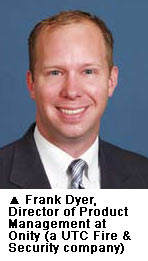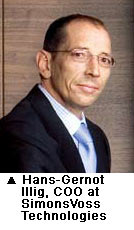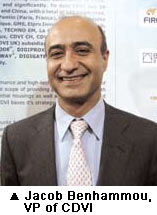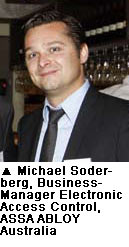As the worldwide economic climate sours, protecting valuable assets and critical sites becomes a concern for all. Stringent access control provides peace of mind, leading to increasing demand on sophisticated locks. A&S looks at how state-of-the-art access control technologies work in unison to deliver heightened security at the door front.
As the worldwide economic climate sours, protecting valuable assets and critical sites becomes a concern for all. Stringent access control provides peace of mind, leading to increasing demand on sophisticated locks. A&S looks at how state-of-the-art access control technologies work in unison to deliver heightened security at the door front.
With today's increasingly "intelligent" criminals, a mere bolt lock is far from optimal. The latest FBI's Uniform Crime Report, "Crime in the United States 2007," suggested that there were more than 9.8 million property crime offenses across America in 2007, with a staggering loss of US$17.6 billion. Offenses include offences burglary, larceny, motor vehicle theft and arson where victims suffer no physical harm but direct financial losses.
Although crime has declined in recent years, the economic downturn is expected to send crime rates soaring. Sophisticated electronic locks are thus sought, as a cost-effective way to prevent unauthorized access. With electronically programmable locking mechanisms in conjunction with mechanical components, traditional locks can be converted to stand-alone access control systems.
The worldwide electronic lock market was pegged at $1.2 billion in 2007, said Frank Dyer, Director of Product Management at Onity (a UTC Fire & Security Company). ASSA ABLOY estimated that, in 2008, four to five million units were put in place, including electric strikes, electromagnetic locks, motor and solenoid locks (residential excluded). "EMEA and North America account for the majority of sales while Asia appears to be the fastest growing," said Michael Soderberg, Business Manager, Electronic Access Control, ASSA ABOY Australia.
"The electronic lock market can be divided into the hospitality and professional  segments," specified Hans-Gernot Illig, COO at SimonsVoss Technologies. The hospitality segment includes all types of hotels, resorts and vacation rentals, while the government, education, health care, financial and commercial verticals consititute the professional segment. "About $300 million in revenue were generated in the professional market in 2008, with EMEA taking the lion's share of $170 million."
segments," specified Hans-Gernot Illig, COO at SimonsVoss Technologies. The hospitality segment includes all types of hotels, resorts and vacation rentals, while the government, education, health care, financial and commercial verticals consititute the professional segment. "About $300 million in revenue were generated in the professional market in 2008, with EMEA taking the lion's share of $170 million."
While these projections vary, access control is without a doubt a lucrative market. The electronic access control system market, in APAC alone, was estimated at $900 million to $1 billion in 2008, according to Parul Oswal, Industry Analyst at Frost & Sullivan.
Technology
Electronic locks vary widely in types and complexity. The hardware comes in different forms, including electromagnetic locks, electronic strikes, electronic mortise, motor and cylindrical locks, exit devices and many others. Locks can be operated by a simple switch or through biometric authentication, safeguarding access to confidential information or restricted areas, from gateway entrances to compact safes.
Numeric code and proximity technology are the most commonly used to control safes. A code- or card-enabled lock consists of a keypad or a built-in card reader,  in addition to standard mechanical components. With the ability to electronically program access codes, blocking lost keys or adding/removing authorized users is made easily. Biometric locks, on the other hand, remain a niche market due to privacy concerns, noted Dyer.
in addition to standard mechanical components. With the ability to electronically program access codes, blocking lost keys or adding/removing authorized users is made easily. Biometric locks, on the other hand, remain a niche market due to privacy concerns, noted Dyer.
Major players include ASSA ABLOY, CDVI, Schlage (Ingersoll Rand), Kaba, Onity, RCG, Salto Systems, SimonsVoss, Videx, Seoul Commtech and Union Community.
Integration
As needs for IP convergence and remote monitoring increase, electronic locks have also evolved, said Chris Kang, Assistant Manager of Home and Security Export, Seoul Commtech, acknowledging the advantage of networkability. "Growing sophistication and a broader spectrum of products allow for greater interoperability while increasing the value of a door opening," said Jennifer Toscano, Marketing Manager for Schlage, Ingersoll Rand Security Technologies.
"Customers want access control, intrusion and identity management all integrated into one single platform for easy management and coordinated crisis responses," said Oswal. Through monitoring locking activities, access control systems can be configured to trigger other events such as sound alarms or lighting activation. American Security, specializing in safe locks, allows its lock controller to be connected to a video recorder for oversight of user activities, whereas RCG equips its biometric locks with fire detection capability.
Electronic locks for doors may be configured in two ways: to an access control  central command or a stand-alone system with fully distributed intelligence. An electronic locking device can be connected to an existing access control system through hardwiring of a reader and a controller, creating a reader-controlled door. Identity verification is carried out at the controller located inside.
central command or a stand-alone system with fully distributed intelligence. An electronic locking device can be connected to an existing access control system through hardwiring of a reader and a controller, creating a reader-controlled door. Identity verification is carried out at the controller located inside.
Some manufacturers develop simplified cable wiring to minimize installation work. With built-in intelligence, ASSA ABLOY's technology enables its locking devices to be connected with a standardized four-wire cable system — including power supply and data communication — and encrypted information is exchanged over a controlled area network. "The demand for intelligent locks is driven by decreasing labor budgets," said Soderberg.
Wireless transmission with remote control capability and centralized data management is on the rise, as well as networked or hybrid systems that minimize administration work, said Illig. "Wireless access control enables less invasive configurations and minimizes disruption during refurbishment," Toscano added. "Architectural integrity of historical buildings is maintained intact as well as avoiding potential asbestos exposure."
Radio waves and IR are the common choices. ASSA ABLOY, Kaba, Schlage and SimonsVoss have all developed network modules with built-in radio transceivers  for WLAN connections, leveraging existing infrastructure and catering to remote monitoring. Given that wireless communication can be critical, vendors are making sure the signal between the lock and the user is fully encrypted.
for WLAN connections, leveraging existing infrastructure and catering to remote monitoring. Given that wireless communication can be critical, vendors are making sure the signal between the lock and the user is fully encrypted.
While adoption of biometric authentication is growing, "most biometric locks still call for hardwired Internet configurations," said JG Kim, VP of Business Development, Union Community. "In general, cable promises a more secured transmission." Locksets with embedded controllers can also be found to contain biometric data for processing at the door. Centralized identify verification, however, is preferred in order to protect private details. Integrated biometric locks are thus configured to interface with the access control panel inside critical sites to eliminate the threat of exposing personal data at the entry point.
Installation
In many cases, electronic locks can be powered by batteries, requiring no external power supply. Without hardwiring, users benefit from the time and cost saved from installation, said Illig.
Videx's electronic cyber locks are powered once the right keys are inserted. "The lock system is immune to electrical outage and will continue to work no matter what a storm or disaster might bring," said Andy Hilverda, VP of Videx.
Ease of implementation is another advantage. Electronic locks should be manufactured as an electronic version of standard mechanical lock hardware, "[so] replacement is as simple as substituting the original mechanical component  with electronic hardware," described Hilverda. Addtionally, plug-and-play operation brings installation time to a minimum and removes the possibility for incorrect connections, Soderberg added.
with electronic hardware," described Hilverda. Addtionally, plug-and-play operation brings installation time to a minimum and removes the possibility for incorrect connections, Soderberg added.
However, diversified ironmongery profile poses challenges. Ironmongery specifications and product standards vary across regions, hindering market uptake, Illing noted. "In Germany, VdS certification is required for security products, and technologies can only be provided by ISO9001-certified manufacturers."
Legacy architecture, such as existing drill holes, has made retrofitting difficult, Dyer added. "As access control represents a multitude of product platforms and unsynchronized databases, inconsistent user interfaces are often uncovered at the management software level," said Toscano.
Legal issues are equally crucial. Electronic locks are governed by building and fire codes that adapt to local and industry needs. To comply with life safety regulations, emergency exits are most defined. BS EN specifications, for example, clearly regulate locks used on escape routes and levers, pads or bars used on emergence exits. For safety concerns, locks usually come with hardware/software override mechanisms in the event of an emergency. "Consult industry experts on local ordinances before embarking on a project," Toscano advised.
Selection Criteria
High-level security, a compatible platform and aesthetic appeal are what users look out for when choosing electronic locks. "Premium solutions do a good job of incorporating these with the latest wireless technology," said Dyer.
Integration of multiple authentication modes adds security as well as providing cost-effective solutions in downturn economies. "A variety of validation modes  means additional choices for personnel," said Nikki Contreras, Administrative Assistant at American Security. Reliable battery power, a long standby time and more openings per battery set are high on the list as well, Illig said.
means additional choices for personnel," said Nikki Contreras, Administrative Assistant at American Security. Reliable battery power, a long standby time and more openings per battery set are high on the list as well, Illig said.
In the real world, a broad range of locks, from computer-programmable to key-operated, can be found in one access control system, making compatible architecture an essential criterion. With a compatible system comes the benefit of an expandable platform. To ensure scalability, adhering to the proven IT industry standards was suggested. "Support to commercially available operating systems such as Linux and Windows should be made available," said Toscano. "Unified communication allows for real-time data sharing and enterprise infrastructure collaboration, including human resources and enterprise resources planning."
Although functionality matters, pleasing appearance has been sought after by the hospitality industry, said Illig. While secure, users prefer aesthetic design for added value.
Furthermore, "ensuring an expeditious and easy installation is another top consideration," noted Jacob Benhammou, VP of CDVI. Down time on critical doors can cause massive cost penalties or loss of revenue, Soderberg said.
Challenges and Future Roadmap
Tailor-made door solutions are in demand. Justifying customers' wish lists while achieving maximum ROI emerges as a major trend, said Contreras. To be cost- effective, manufacturers can opt for widely accepted wireless technology, suggested Soderberg.
effective, manufacturers can opt for widely accepted wireless technology, suggested Soderberg.
"Customers today agree that the benefits of electromechanical locks far exceed the incremental upfront cost," Dyer said. However, in financially difficult times, to provide a locking system with miniaturized electronics and maximized battery capacity, coupled with minimized cost, is not an easy task, Soderberg added.
Merging mechanical and electronic knowledge remains the primary technical barrier for manufacturers and installers, as locksmiths and electricians may not be acquainted with both, said Benhammou.
As for biometrics, some people are just not ready to put their trust in it due to personal skepticism, said Dr. Sri Hartati Kurniawan, CTO of RCG. "User education is constantly required."
The market for electronic locking systems is still at its infant stage in most regions, said Illig, forecasting growth opportunities. "Rising crime rates and threat of terrorism continue to drive the market for electronic locks," Hilverda explained.
Pricing and high-security value make electronic locks ideal for a myriad of market segments. "Electronic locks typically follow traditional verticals for access control systems," Soderberg said. "Health care and education are seeing rapid growth." Government and educational facilities, as well as commercial buildings like corporate offices and retail stores, are growing at approximately 6 percent a year, according to Onity's estimation.
Electronic digital door locks are also gaining traction in Asia, even though they only account for a small portion of the market today, said Kang. Other areas of growing  demand are critical infrastructure such as utilities, control rooms, and sensitive places like borders and immigration points, said Benhammou.
demand are critical infrastructure such as utilities, control rooms, and sensitive places like borders and immigration points, said Benhammou.
Wireless developments will keep the momentum up, predicted Soderberg. A locking solution with the ability to communicate with PDAs and mobile phones presents great potential. "Near-field communication will be an important standard in the future in order to marry the key to the phone."
The market is moving toward integrating physical and network security. The rise of IP convergence means there is a need for standardized communication protocols. "Specifications on minimum encryption levels, data and system integrity are important areas to be defined," said Soderberg. Enterprise applications, including time and attendance and centralized network management, are promising, said Dr. Kurniawan. In short, a company's logical security must be linked seamlessly with its access control system, Toscano said.
More Advantages
● Price performance: Electronic locks enable affordable upgrades and bring about long service life, offsetting initial investment. “Typically, locksmiths charge US$96 for rekeying the first door and $25 each for the rest that need to be rekeyed,” said Hilverda. “Digitally programmable locks eliminate the risk of putting the entire system in jeopardy with unaccounted keys and save subsequent costs.”
● Audit: Electronic locks can track the traffic to and from the site, recording when the doors have been opened and by whom, Hilverda said. An audit trail can be produced for evidentiary purposes, and instantaneous reports with time-stamped events are made possible.
● Drillproof: Most high-security locking devices are designed to be vandal-proof and sabotage-resistant. Hardened housing and anti-drill steel plate are common protective measures.